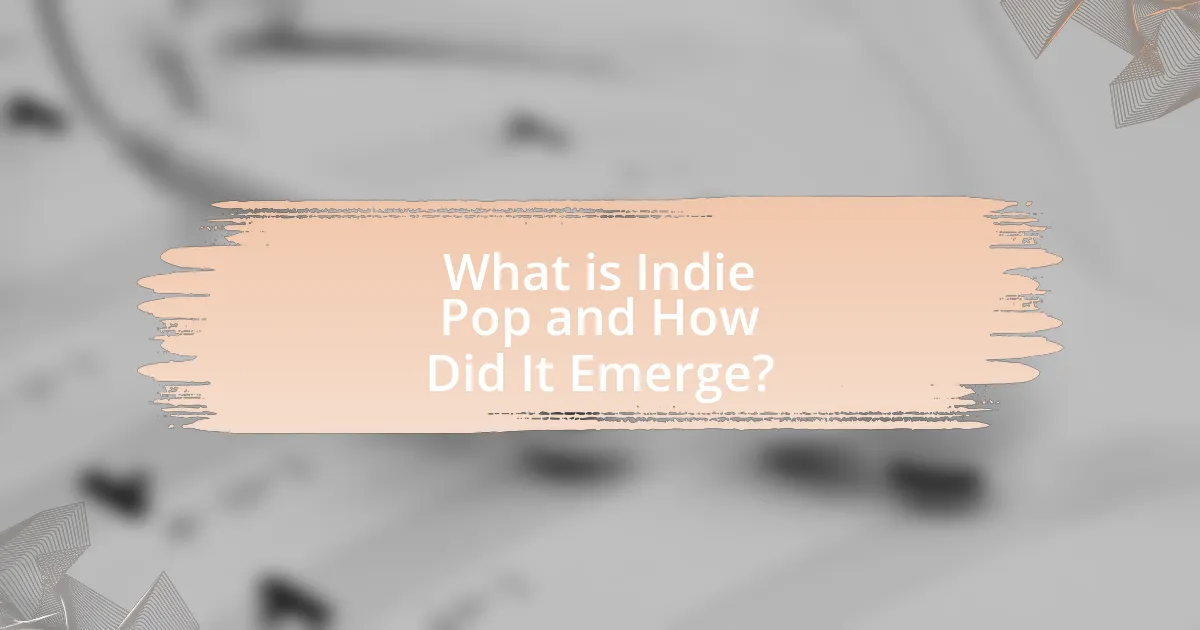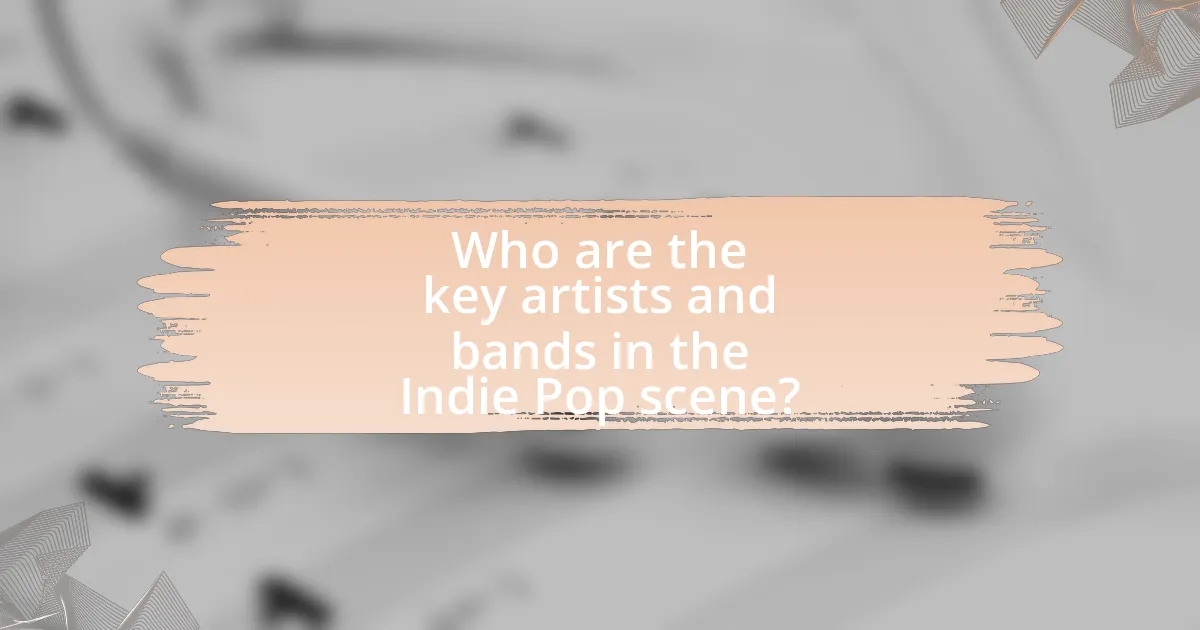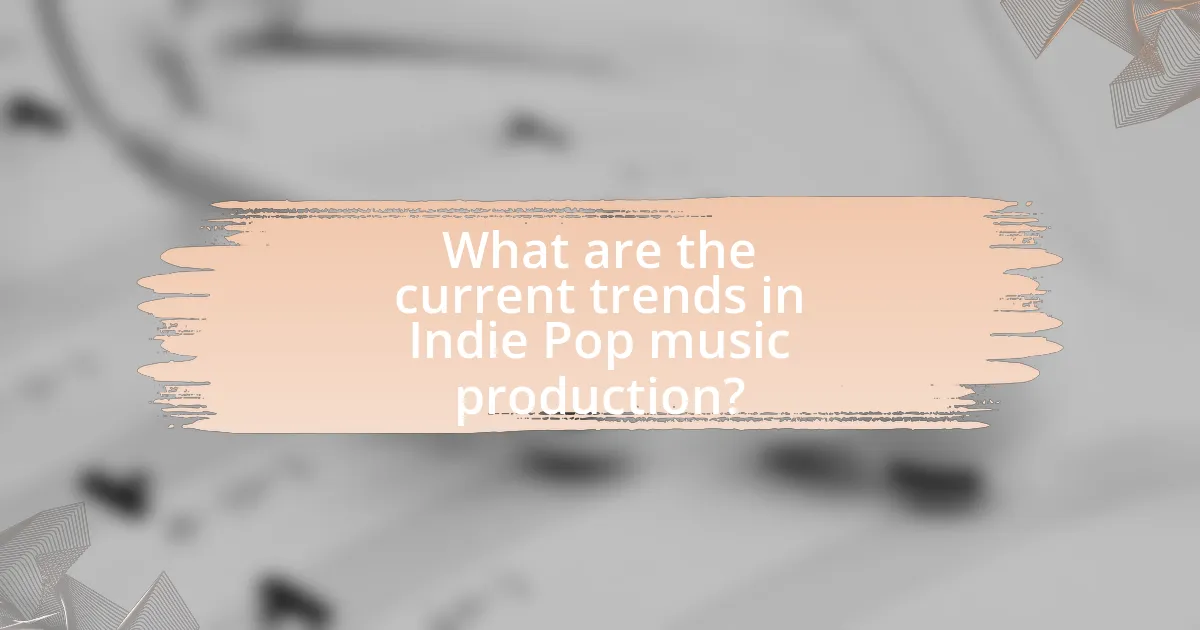Indie pop is a music genre that emerged in the late 1970s and early 1980s, characterized by independent production and melodic, introspective songwriting. The article explores the defining characteristics of indie pop, its evolution through influential artists and bands, and the impact of digital platforms and social media on its popularity. It also examines the role of collaborations in shaping the genre, current trends in music production, and emerging sub-genres within indie pop. Additionally, the article highlights best practices for aspiring indie pop artists to establish their unique sound and engage with audiences effectively.

What is Indie Pop and How Did It Emerge?
Indie pop is a genre of music characterized by its independent production and a focus on melodic, often introspective songwriting. It emerged in the late 1970s and early 1980s as a response to the mainstream music industry, with bands like The Velvet Underground and The Smiths influencing its development. The genre gained traction through independent record labels and DIY ethics, allowing artists to create and distribute music outside of major label constraints. By the 1990s, indie pop had further evolved, with bands such as Belle and Sebastian and The Magnetic Fields contributing to its popularity, showcasing a diverse range of sounds and lyrical themes. The rise of digital platforms in the 2000s further propelled indie pop, enabling artists to reach wider audiences without traditional marketing channels.
What are the defining characteristics of Indie Pop?
Indie Pop is characterized by its melodic sound, DIY ethos, and a focus on artistic expression over commercial success. This genre often features catchy hooks, diverse instrumentation, and a blend of various musical influences, including rock, electronic, and folk. The DIY ethos is evident in the way many Indie Pop artists produce and distribute their music independently, often through small labels or self-released platforms. Additionally, lyrical themes in Indie Pop frequently explore personal and introspective subjects, setting it apart from mainstream pop music. The genre gained prominence in the 1980s and 1990s, with bands like The Smiths and Belle and Sebastian exemplifying its defining traits.
How does Indie Pop differ from mainstream pop music?
Indie Pop differs from mainstream pop music primarily in its production approach and artistic freedom. Indie Pop is typically characterized by a DIY ethos, where artists often produce their music independently without the backing of major record labels, allowing for more creative control and experimentation. In contrast, mainstream pop music is usually produced with significant commercial intent, often involving large budgets, extensive marketing, and a focus on mass appeal. This distinction is evident in the sound and lyrical content, where Indie Pop often explores niche themes and unconventional structures, while mainstream pop tends to prioritize catchy hooks and broad relatability.
What influences shaped the sound of Indie Pop?
The sound of Indie Pop has been shaped by a combination of alternative rock, punk, and lo-fi aesthetics. Alternative rock, particularly from the 1980s and 1990s, introduced a more melodic and experimental approach, influencing bands like The Smiths and R.E.M. Punk’s DIY ethos encouraged artists to produce music independently, fostering a sense of authenticity and creativity. Additionally, the lo-fi production techniques, popularized by artists such as Daniel Johnston and Guided by Voices, contributed to the genre’s distinctive sound, emphasizing rawness and emotional honesty. These influences collectively define the Indie Pop sound, making it diverse and reflective of various musical traditions.
Why has Indie Pop gained popularity in recent years?
Indie Pop has gained popularity in recent years due to its unique sound, accessibility through digital platforms, and the rise of social media marketing. The genre’s distinct blend of catchy melodies and diverse influences appeals to a wide audience, while platforms like Spotify and YouTube have made it easier for independent artists to reach listeners without traditional record label support. Additionally, social media allows for viral marketing, enabling songs to gain traction quickly, as seen with tracks like “Peach” by Kevin Abstract, which garnered millions of streams and widespread recognition. This combination of factors has contributed to the genre’s significant growth in the music landscape.
What role do social media and streaming platforms play in its rise?
Social media and streaming platforms significantly contribute to the rise of indie pop by providing artists with accessible channels to reach audiences directly. These platforms enable independent musicians to share their work without the need for traditional record labels, allowing for greater creative freedom and diverse soundscapes. For instance, Spotify reported that over 60% of its streams come from independent artists, highlighting the platform’s role in democratizing music distribution. Additionally, social media platforms like Instagram and TikTok facilitate viral marketing, where songs can gain popularity through user-generated content, further amplifying the reach of indie pop artists.
How have cultural shifts contributed to the Indie Pop movement?
Cultural shifts have significantly contributed to the Indie Pop movement by fostering a desire for authenticity and individuality in music. The rise of digital technology and social media has enabled independent artists to reach audiences directly, bypassing traditional music industry gatekeepers. This democratization of music production and distribution has led to a diverse range of sounds and styles within the Indie Pop genre, reflecting broader cultural trends such as DIY ethics and a rejection of mainstream commercialism. For instance, platforms like Bandcamp and SoundCloud have empowered artists to share their work without major label support, resulting in a flourishing of unique voices and innovative approaches to music.

Who are the key artists and bands in the Indie Pop scene?
Key artists and bands in the Indie Pop scene include Tame Impala, Vampire Weekend, and Florence + The Machine. Tame Impala, led by Kevin Parker, is known for its psychedelic sound and has received critical acclaim, including a Grammy Award for Best Alternative Music Album. Vampire Weekend, formed in 2006, has been influential in blending various musical styles and has won multiple Grammy Awards, showcasing their impact on the genre. Florence + The Machine, fronted by Florence Welch, has garnered significant recognition for their powerful vocals and emotive performances, earning several awards, including Brit Awards and Grammy nominations. These artists exemplify the diversity and creativity within the Indie Pop genre.
What are some notable Indie Pop artists to watch?
Notable Indie Pop artists to watch include Phoebe Bridgers, known for her introspective lyrics and unique sound, and Snail Mail, recognized for her emotional depth and guitar-driven melodies. Additionally, Japanese Breakfast has gained attention for her innovative approach to genre blending and captivating performances. These artists have been highlighted in various music publications and platforms, showcasing their growing influence in the Indie Pop scene.
How have these artists influenced the genre?
These artists have significantly influenced the indie pop genre by introducing innovative sounds and diverse musical elements. Their experimentation with unconventional song structures and blending of genres has expanded the sonic palette of indie pop, making it more eclectic and appealing to a broader audience. For instance, artists like Sufjan Stevens and Florence + The Machine have incorporated orchestral arrangements and electronic elements, which have set new standards for production quality and artistic expression within the genre. This shift has led to a surge in popularity for indie pop, as evidenced by increased streaming numbers and chart success, demonstrating their lasting impact on the genre’s evolution.
What are the common themes in their music?
Common themes in indie pop music include introspection, emotional vulnerability, and social commentary. Artists often explore personal experiences and relationships, reflecting feelings of love, heartbreak, and self-discovery. Additionally, many songs address broader societal issues, such as mental health, identity, and the complexities of modern life. This thematic diversity resonates with listeners, making indie pop relatable and impactful. For instance, the song “Breezeblocks” by alt-J delves into themes of obsession and longing, while “Dog Days Are Over” by Florence + The Machine celebrates liberation and personal growth.
How do collaborations shape the Indie Pop landscape?
Collaborations significantly shape the Indie Pop landscape by fostering innovation and expanding artistic boundaries. When artists from diverse backgrounds come together, they blend unique styles and influences, resulting in fresh sounds that resonate with a broader audience. For instance, the collaboration between indie artists and mainstream producers often leads to the creation of hybrid genres, which can attract listeners from both spheres. A notable example is the partnership between indie band Tame Impala and pop artist Lady Gaga, which introduced psychedelic elements into pop music, demonstrating how cross-genre collaborations can redefine musical norms. Additionally, collaborations can enhance visibility for emerging artists, as established names often bring their fanbase, thereby increasing exposure and opportunities for indie musicians. This dynamic interplay not only enriches the Indie Pop genre but also contributes to its evolution and relevance in the contemporary music scene.
What impact do collaborations have on genre evolution?
Collaborations significantly accelerate genre evolution by blending diverse musical styles and influences. For instance, the partnership between artists from different genres, such as indie pop and electronic music, creates innovative sounds that challenge traditional genre boundaries. A notable example is the collaboration between indie pop artist Sufjan Stevens and electronic musician Angelo De Augustine, which resulted in a unique fusion that expanded the sonic palette of both genres. This blending not only introduces new elements but also attracts varied audiences, further driving the evolution of music genres.
Which collaborations have been particularly influential?
Collaborations between artists such as Sufjan Stevens and Angelo De Augustine, as well as the partnership of Bon Iver and James Blake, have been particularly influential in the indie pop genre. These collaborations have resulted in critically acclaimed albums that blend unique sounds and emotional depth, showcasing the versatility and innovation within modern soundscapes. For instance, Stevens and De Augustine’s album “A Beginner’s Mind” received praise for its introspective lyrics and intricate arrangements, while Bon Iver’s work with Blake on tracks like “I Need a Forest Fire” highlights the fusion of electronic and acoustic elements, pushing the boundaries of indie pop.

What are the current trends in Indie Pop music production?
Current trends in Indie Pop music production include the use of lo-fi aesthetics, incorporation of electronic elements, and a focus on DIY recording techniques. Lo-fi production, characterized by its raw and unpolished sound, has gained popularity as artists seek authenticity and intimacy in their music. Additionally, the blending of electronic sounds with traditional instruments allows for innovative soundscapes, appealing to a broader audience. The DIY approach, facilitated by accessible recording technology and platforms like Bandcamp and SoundCloud, empowers artists to produce and distribute their music independently, reflecting a shift towards self-sufficiency in the industry. These trends are supported by the rise of platforms that promote independent artists, showcasing their work and connecting them with listeners globally.
How has technology changed the way Indie Pop is produced?
Technology has significantly transformed the production of Indie Pop by enabling artists to create high-quality music with accessible tools. Digital audio workstations (DAWs) like Ableton Live and Logic Pro allow musicians to record, edit, and mix tracks from home studios, reducing the need for expensive studio time. Additionally, advancements in software plugins and virtual instruments provide a wide range of sounds and effects that were previously only available in professional settings. The rise of online distribution platforms like Bandcamp and Spotify has also changed how Indie Pop is marketed and shared, allowing artists to reach global audiences without traditional record label support. This democratization of music production and distribution has led to a diverse array of sounds and styles within the Indie Pop genre.
What tools and software are commonly used in Indie Pop production?
Common tools and software used in Indie Pop production include Digital Audio Workstations (DAWs) like Ableton Live, Logic Pro, and FL Studio, as well as plugins such as Serum, Omnisphere, and various effects processors. These DAWs provide essential features for recording, editing, and mixing music, while plugins enhance sound design and add unique textures to tracks. The popularity of these tools is evidenced by their widespread use among Indie Pop artists and producers, facilitating creativity and innovation in the genre.
How do production techniques affect the sound of Indie Pop?
Production techniques significantly shape the sound of Indie Pop by influencing its texture, instrumentation, and overall aesthetic. For instance, the use of lo-fi recording methods often results in a raw, unpolished sound that is characteristic of many Indie Pop tracks, allowing for a more intimate and authentic listening experience. Additionally, layering of instruments and vocal harmonies can create a rich soundscape, enhancing emotional depth. The incorporation of electronic elements, such as synthesizers and drum machines, further diversifies the genre, allowing artists to experiment with different sonic palettes. This blending of traditional and modern techniques is evident in the works of artists like Tame Impala and Vampire Weekend, who utilize both organic and digital sounds to craft their unique identities within the Indie Pop genre.
What are the emerging sub-genres within Indie Pop?
Emerging sub-genres within Indie Pop include Dream Pop, Chillwave, and Synth-Pop. Dream Pop is characterized by its ethereal soundscapes and introspective lyrics, often utilizing reverb-heavy guitars and soft vocals. Chillwave incorporates lo-fi production techniques and nostalgic elements, creating a relaxed, summery vibe. Synth-Pop, which has seen a resurgence, emphasizes synthesizers and electronic beats, blending pop sensibilities with retro influences. These sub-genres reflect the evolving landscape of Indie Pop, showcasing diverse sounds and innovative approaches to music production.
How do these sub-genres reflect broader musical trends?
Sub-genres of indie pop reflect broader musical trends by showcasing a blend of diverse influences and innovative production techniques. For instance, the rise of lo-fi aesthetics within indie pop mirrors the increasing consumer preference for authenticity and raw sound, as evidenced by the popularity of artists like Mac DeMarco and Clairo, who utilize home recording methods to create intimate music experiences. Additionally, the incorporation of electronic elements in sub-genres like synth-pop highlights the broader trend of genre fusion, aligning with the mainstream’s embrace of electronic music, as seen in the success of artists like CHVRCHES. These sub-genres not only adapt to but also shape the evolving landscape of contemporary music, illustrating the dynamic interplay between niche and mainstream audiences.
What are some examples of successful sub-genres in Indie Pop?
Successful sub-genres in Indie Pop include Dream Pop, Twee Pop, and Chillwave. Dream Pop, characterized by its ethereal sound and atmospheric production, gained popularity in the late 1980s and early 1990s with bands like Cocteau Twins and later artists such as Beach House. Twee Pop, known for its catchy melodies and whimsical lyrics, emerged in the 1980s with groups like Belle and Sebastian, appealing to a niche audience. Chillwave, which surfaced in the late 2000s, features lo-fi production and nostalgic themes, with artists like Washed Out and Toro y Moi leading the movement. Each of these sub-genres has contributed to the broader Indie Pop landscape, showcasing diverse sounds and attracting dedicated fan bases.
What are the best practices for aspiring Indie Pop artists?
Aspiring Indie Pop artists should focus on developing a unique sound, building a strong online presence, and engaging with their audience. A unique sound differentiates artists in a crowded market, allowing them to stand out and attract listeners. Building a strong online presence through social media platforms and music streaming services is crucial, as 90% of music discovery now occurs online. Engaging with the audience through live performances, social media interactions, and fan events fosters a loyal fanbase, which is essential for long-term success in the Indie Pop genre.